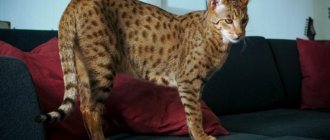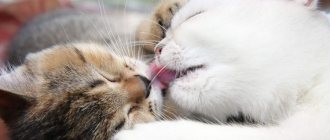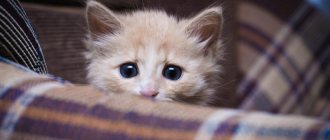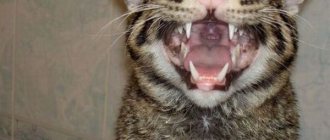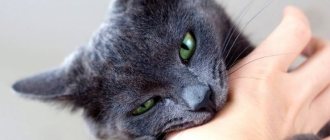Little cats - big story
In 1831, the French naturalist Isis Saint-Hilaire obtained a small spotted skin. Having carefully examined it, he decided that it belonged to an animal unknown to science, which he named Prionailurus rubiginosus (rusty) because of the spots that resembled rust. Since then, the rusty cat became known not only to zoologists, but also to everyone who was in one way or another familiar with the works of this scientist, who made the first detailed description of the rusty cat.
It is not surprising that the animal aroused keen interest among everyone who wanted to see it in its natural habitat. But viewing a wild purr in natural conditions, much less taking a photograph of it, has always been extremely difficult.
To capture the animal, you will have to go to Sri Lanka, Nepal or India, but it is not a fact that you will be able to film the cat, because it comes out of hiding to hunt only at night. Moreover, he steps so quietly that he hardly makes any rustling sounds. So the very first photograph of a cat was taken only six years ago in a national park in Nepal.
It is noteworthy that for this purpose, as many as thirty-seven hidden cameras were installed in the park, and only one of them took the picture.
Now there are few rusty cats left on our planet, approximately 10,000 individuals. Therefore, rusty cats are listed in the Red Book. Hunting these cats is prohibited in Nepal and India.
Behavior and characteristics of hunting
Rusty cats are nocturnal predators. Representatives of this breed look for their prey on the ground and always try to stay near trees so that if danger approaches, they can climb them. Animals are excellent steeplejacks, distinguished by their agility, dexterity and speed of reactions.
Excellent vision and acute, subtle hearing help animals both in hunting and in self-defense, when it is necessary to hide from dogs, people or larger predators. The unusual coat color makes it easy to camouflage in its natural habitat.
The diet of rusty cats, in addition to insects, can include frogs, small birds and rodents. These animals and plant foods are consumed, although it constitutes only a small percentage of the daily diet.
What is she like, a rusty spotted cat: appearance, character, habitat
The ginger cat, at first glance, is a very cute creature, wearing a soft fluffy coat of brownish-gray color with undercoat. Indeed, people should not fear anything when meeting her. Due to its small size, it could not cause harm, even if it wanted to.
Appearance
Since the cat comes from approximately the same region as the Bengal, their colors are somewhat similar. If in Nepal and India red tones predominate in the color, then in Sri Lanka more gray is “added” to it, the cats’ fur is grayish-red.
On the neck and belly of the animal, the fur is white with yellow stripes and spots. Four thin dark stripes stretch from the eyes to the ears, ending at the spine. The ears are large, widely set and rounded at the ends. The eyes are also large, bulging, orange or yellow.
The pads on the paws are black, the whiskers are half white, half black. The length of the tail reaches 30 cm.
She has the same slender and agile, but small body. Males grow up to 1.6 kg, and females are even smaller.
Populations
So far there are only two types of animals. Some live in India, others in Sri Lanka. The main difference is the color. In the Indian cat, red tones predominate, while in another species, gray tones predominate.
Character
The rusty cat is a true fearless hunter. Despite its small size, it is not only ready to defend itself to the end, but also to attack large game.
There is a known case when an animal, whose weight did not reach two kilos, rushed at a roe deer, grabbing its neck. This incident was witnessed by the famous scientist Thomas Jordan. It is noteworthy that the cat was tamed and lived with people.
Interestingly, cats are very friendly towards people. Adult cats do not bite, even if they are caught and locked in a cage. And they only rush around in fear, trying to get out. But kittens that people tame at an early age adore them and completely trust them. .
There is a known case where two kittens of a rusty cat were tamed by an employee of the Indian National Park. They slept in his tent in a basket with bedding. Despite the fact that they moved freely through the jungle, each time the brothers returned home.
As they grew older, they also expressed their love and trust. While the owner was working, one of the kittens slept on his lap, and the second sat on the back of a chair and hugged the scientist with his paws.
Unfortunately, one of the kittens was bitten by a snake and died, even though the owner did not try to save him. Then a new playmate was brought to the wild kitten, an ordinary domestic kitten.
At first the savage did not recognize him and hissed, but later he became friends. However, the pet could not replace his deceased brother. He could not climb the banyan tree so quickly and high, and he began to scream as soon as he climbed a little higher into the tree, and he had to be removed from there. Therefore, the rusty kitten gave in to his “underdeveloped” domestic brother and ran around with him more on the ground. He almost didn't climb the trees.
Rusty cats live in many zoos, and keepers do not have any problems. Despite their love of hunting, they never attack humans. If you take a baby rusty cat, he will be as affectionate and playful as any pet.
External features
How to accustom a cat to a new home - arrangement and adaptation options for your pet
The spotted ginger cat was first described by a French zoologist in the 1830s. He drew attention to the skin of an unknown fur-bearing animal sent to him, which was covered with bright brown blurry spots. Thanks to this feature, the cat began to be called rusty.
Rusty cat kitten is very small in size
A miniature cat measuring from 35 to 48 cm. Weight can vary from 0.9 to 1.6 kg. The coat is short, thick, light gray in color with rusty spots without clear edges. The muzzle is small and round with straight, rounded ears.
You can find information that the rusty cat is the smallest representative of its species. But that's not true. The black-footed cat is the name given to the smallest wild cat in the world. The animal lives in Africa and has a striped color.
Subspecies of rusty cat
There are 2 subspecies of this breed. One lives in India and prefers to settle in open steppe areas. Another lives in Ceylon in the tropical forests. The representative, called the Indian rusty cat, is light gray in color with a reddish tint. Ceylon cat with a brown head and dark gray body. In both subspecies, the belly and inner side of the paws are white with black transverse stripes, and individuals are of the same size.
For your information! These subspecies differ not only in coat color and habitat. The Ceylon cat has brighter colors and prefers to live in forests.
Advantages and disadvantages
As already mentioned, wild cats quickly become attached to their owners, but require certain conditions for keeping in captivity. Therefore, if you decide to purchase a wild beauty, keep in mind that it has its own advantages and disadvantages.
The advantages, of course, include small size, which causes affection, unusual appearance, easy care, great activity and playfulness. A significant plus is attachment to the owner and devotion.
But still, these are wild cats and they can sometimes be aggressive. Although the owners are not in serious danger, pets sometimes hiss and bite. The apartment is not suitable for their maintenance. They need an enclosure where they can feel at home.
Therefore, cats are more suitable for keeping in country houses. And the price for them is steep.
Character and temperament
Ocelot (cat): a complete overview of the wild breed
In nature, a cat behaves very carefully. Cameras installed in national parks do not often capture cautious animals. The miniature dimensions of this baby among the cat species do not prevent him from being an active, merciless hunter. A cat weighing 2 times less than a domestic cat without fear rushes at prey larger than itself. The rusty cat is called a born hunter. However, her predator instinct fades when interacting with humans. A tamed cat is attached to its owner and takes part in games with pleasure.
Important ! The rusty cat is a merciless hunter, in the hands of a person it becomes affectionate and harmless.
These animals hunt mainly birds
Habitat
The natural habitat for cats is forests, rocks, meadows. They can also settle in tea and coconut plantations, rice fields, etc.
The only countries where they are found are Sri Lanka, Nepal and India. For example, in Northern India they live in the state of Uttar Pradesh, and are also found in Western Maharashtra, the western Ghats and the Varushanad valley. Another region where they live is the state of Gujarat, where there are dry and tropical forests.
There are also two reserves where rusty cats can be found: Nugu (Karnataka), Nagarjuna Sagar Srisailam (Andhra Pradesh Tiger Reserve).
Cats do not always live in forests. If there are rodents nearby, the animals take up residence in abandoned houses. For example, they can often be found in settlements in southern India, located at great distances from forests.
Menu
The rusty cat's favorite treat is small rodents and birds. Residents of India saw that rusty cats hunt mice and frogs that appear after the winter rains. If given the opportunity, a rusty cat may attack poultry, chickens and ducks.
At the zoo, the diet of animals is different. So in Frankfurt they are fed beef, beef heart, chickens, mice. The menu also includes vegetables, apples, and boiled rice. Sometimes they are given fish and bananas.
If a cat lives at home, in addition to meat and fish, she should be given egg yolks, fermented milk products, and greens.
Who is he hunting?
Cats are most active at night, and this species is no exception. During the day, cats camouflage themselves, resting in the crowns or hollows of trees. As soon as night falls, the predator becomes more active, sharpening its senses. They are excellent hunters thanks to their keen eyesight and sensitive hearing.
The rusty cat eats animal food, preferring:
- gophers;
- rats, mice;
- lizards;
- birds;
- frogs;
- fish.
In the absence of desired victims, it feeds on insects. During the “hungry” period, a small predator is able to sneak into the chicken coop and attack a chicken or duck (wild nature makes itself felt).
The cat hunts for a long time, lying in wait for its prey. Overtakes the game with a sharp jump, piercing the back of the head. It eats its prey immediately, leaving nothing behind. Rusty cats prefer to live and hunt on the ground. They can swim and are not afraid of water, unlike ordinary cats. Therefore, if they need to get to the other side, they will swim across the river without hesitation.
Mating and offspring
During the mating season, male rusty cats are allowed to be in the territory of females, and vice versa. As for zoos, the female remains in the male's territory even after she gives birth to her babies. In one of these establishments, the male even attacked the attendants who were feeding the cats, because he believed that his offspring needed protection.
In the natural environment in India, kittens are born in the spring, after 67 days of mother's pregnancy. As a rule, this happens in a secluded lair, a cave.
In Sri Lanka, tree hollows or small caves under rocks can become breeding grounds. An hour after the babies appear, the mother leaves them for a while, going in search of food. After about a month, the kittens also begin to leave their shelter, and after 40 days they are already able to climb trees, and at 50 they can jump from a height of two meters.
Most of the time they play and sleep near their mother, as they get tired very quickly. Up to 40 days, babies eat only milk, then the diet is replenished with meat.
Reproduction
Reproduction among representatives of the species is not much different from the corresponding mating season of ordinary pets. During the courtship period, the red spotted cat violently shows feelings. Loud screams and purrs are a kind of signal to females, who at the initial stage show their independence and disinterest.
After persistent courtship, displays of affection and rubbing her muzzle on the fur, the female, changing her anger to mercy, still mates, with an often irritated and exhausted male. Mating of rusty cats lasts from 1 to 7 minutes, and is repeated several times throughout the day.
After two and a half months, blind kittens are born, smaller than a human little finger, with smooth, light gray or ash-colored fur. As a rule, the number is from one to three individuals.
Taking care of newborns, the female rusty cat uses foliage, moss and tree branches to create a soft and warm den in hard-to-reach places that are not easily accessible to larger and more agile enemies.
Rusty cat kittens become independent after the sixth month of maternal care. By this age, the color of kittens becomes closest to the color of adult animals, and the hunting skills inherent in nature and received from the mother begin to gradually be used when going hunting to obtain their own food.
Enemies of the Rusty Cat
Oddly enough, in fact, the main enemy for cats is people who cut down forests, disturbing their habitat. Cats can be destroyed if they actively steal poultry, despite the fact that the animals are listed in the Red Book. In some regions, cats are even eaten, and their meat is highly valued.
As for predators, it is not yet known whether larger animals can be dangerous to cats. But this is quite possible.
The importance of owls for nature and humans
For humans, owls are of great economic importance. Many species feed on rodents, limiting their spread in rural areas, thereby bringing great benefits to people. Predators also prey on sick birds.
You can train an owl
Owls contribute to the spread of various plants by carrying their seeds on their legs and body to new territories. Poultry waste is of great value for summer residents, as it serves as an excellent fertilizer.
Owls have a beautiful appearance, and people have been taming them for a long time. Surprisingly, the predator quickly abandons life in the wild and gets used to human care.
Spotted cat health
Rusty cats were not subject to mutations and are in excellent health. They have excellent immunity, high resistance to stress, and are extremely resilient, as they are forced to survive in the wild. Not a single domestic pet is capable of climbing a tree so quickly and rushing at prey that is larger than a cat.
Scientists say that cats that live in zoos around the world are not prone to disease. The only thing that can seriously undermine the health of cats with rusty spots is an incorrectly formulated diet.
However, when cats are not in a natural environment, their immunity decreases. In zoos they are given vaccinations. The procedure should also be carried out if you keep your cat at home. Therefore, they receive vaccinations according to the schedule drawn up by the veterinarian, just like other cats.
If a cat is properly cared for, it can live up to 12 years at home. And in nature – up to 15 years.
Animals remain in good physical shape until old age. It’s just a pity that these beautiful little animals are becoming fewer and fewer in their natural habitat due to poaching and narrowing of their habitat.
Origin of the species
This is a wild variety of the Asian cat, a close relative of the Bengal (precisely wild, do not confuse it with the domestic one).
The spotted-red cat is considered the smallest representative of the cat species in Asia; in Africa it is the Black-footed cat, which is almost the same size.
The weight of an adult Rusty cat is from 900 g to 1.5 kg. The maximum body length without tail is 47 cm. A medium-sized animal can easily fit in the palm of an adult man.
The first mention of this cat species in specialized literature dates back to 1831.
Can a rusty cat live in captivity?
For many years now, cats with rusty spots have been living in various zoos around the world, but their conditions there are as close to natural as possible. Currently, about 60 cats from India and Sri Lanka live in 9 zoos. Prionailurus rubiginosus can be seen at the Paris Zoo, Ostrava (Czech Republic). In Frankfurt (Germany), Cincinnati (USA) they successfully breed these amazing animals.
As for the homeland of spotted cats in India, they have adopted a special program for breeding animals in zoos. Local people in India often domesticate animals, and they live next to humans, almost like cute pets.
What is needed to keep a wild cat at home?
If you decide to get a wild rusty cat, an ordinary apartment and the conditions that are usually offered to domestic pets will not be suitable. For the kitten you will have to make an enclosure fenced with a net. Its height should be at least three meters, and bamboo, ficus and other tropical plants should be planted inside.
It is important to maintain the temperature at least 30 degrees. If the cat is cold, it will die from hypothermia. For this reason, she can live in an outdoor enclosure only in the summer, and in the winter she must “move” to a room that is well heated.
The “environment” in the enclosure should be the same as in the forest of India. It’s good if there are logs in which voids have formed. This is an ideal option for cats to hide. But if there is no such material, then you will have to build a “cat house”: make something like a pipe with several exits from the boards.
A linen bedding, preferably burlap, is placed in the house. One piece of fabric is cut into two parts so that one can be put in the house and the other can be left for replacement. Cats do not like and are afraid of new smells. Therefore, while you wash one bedding, exactly the same one will lie in the shelter.
Can I keep it at home?
A definite answer to this question can only be given by a person who has encountered an African wild cat in his home. One thing is certain: this temperamental animal will definitely not be tame and docile. Admiring and being touched by the faces of these predators in the pictures, you will not know what a black-footed cat is like in reality. And it is even more difficult to imagine the unimaginable costs associated with its maintenance.
So, before you look for a nursery that sells these exotic animals, it is worth knowing the basic rules for caring for them and the measures that you will have to take before an African black-footed cat crosses the threshold of your home.
large space for your movements
Important! The main thing is that there is enough space in the enclosure for the animal to move freely, be active and rest. Nothing here should create discomfort for this wayward predator.
Secondly, the diet of a black-footed cat should be rich in fresh meat, the owner will have to take care of the timely supply of it. And besides meat, this animal needs cartilage, veins and offal, from which it receives some essential nutrients, and also properly develops its jaw muscles. Thirdly, your pet will need appropriate veterinary services, which include routine examinations and many vaccinations, because our climate and living conditions bear little resemblance to the arid desert tropics.
How to keep a predatory animal?
Wild pets will happily eat live meat from birds, mice, and even insects. The diet may include poultry and small rodents. Vitamins are needed. The animals are fed for six days, and on the seventh they are left without food, since they must fast for one day. You should play with kittens more when they begin to get used to their owner and get accustomed to their nickname.
If you want to start breeding animals, you should follow the example of the zoo workers from Frankfurt. You need to take a boy and a girl from different cats when they are no more than 3 months old, and raise them together.
Finding a mate for an adult cat is much more difficult, since cats are loners by nature. There is too high a chance that they will not get along and the couple will not work out.
Some interesting facts from the life of rusty cats
Rusty cats “walk by themselves” and are loners, each of them has their own territory, which only cats of the opposite sex can enter during the mating season.
Spotted animals are not afraid of water, swim beautifully and even catch fish, which they love to feast on. Poultry sometimes also becomes prey for cats, which local residents really don’t like. If a cat gives birth to kittens, they will definitely be of the same sex. Usually these are two babies, sometimes three.
Few people have managed to photograph a rusty cat in its natural habitat. So far, there are no more than a dozen photos of rusty beauties that were taken not in zoos, but in nature, and even then after 2005.
Habitat and role in the ecosystem
The American predator lives mainly in Bolivia, but some populations have been found in Bolivia and Argentina (northwestern part of the country), as well as in Chile and Peru. For living, the cat chooses a rocky valley, near which there are slopes and ridges (hills, stones, etc.). It will not be difficult for the animal to climb to a height of up to 5 km. The air temperature in such places may not reach 4 degrees Celsius. Sometimes frosts are possible, but even in this case the cat will not abandon its favorite area.
There are suggestions that the cat prefers heights due to its need for water. In wooded areas and deserts, water is scarce. And going out into the open to the only available source of water is an unaffordable luxury for a mysterious cat. It is easier to find water in the mountains. Melting glaciers become a source of life-giving moisture.



